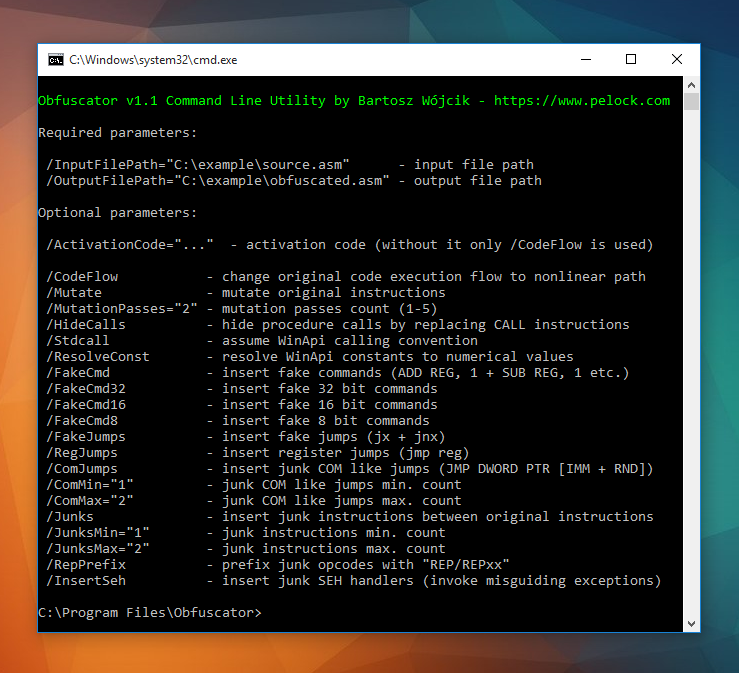Crack Obfuscated Code Examples
For the term as used in natural language, see. In, obfuscation is the deliberate act of creating or that is difficult for humans to understand. Like in, it may use needlessly roundabout expressions to compose statements. Programmers may deliberately obfuscate code to conceal its purpose or its logic or implicit values embedded in it, primarily, in order to prevent tampering, deter, or even as a or recreational challenge for someone reading the source code. This can be done manually or by using an automated tool, the latter being the preferred technique in industry. Contents. Overview The architecture and characteristics of some languages may make them easier to obfuscate than others., and the are some examples of languages easy to obfuscate.
Recreational obfuscation Writing and reading obfuscated source code can be a. A number of programming contests reward the most creatively obfuscated code, such as the and the. Types of obfuscations include simple keyword substitution, use or non-use of whitespace to create artistic effects, and self-generating or heavily compressed programs. According to, techniques may include:.
naming obfuscation, which includes naming variables in a meaningless or deceptive way;. data/code/comment confusion, which includes making some actual code look like comments or confusing syntax with data;. double coding, which can be displaying code in poetry form or interesting shapes. Short obfuscated programs may be used in of Perl programmers. These are JAPHs (').

Reverse Engineering Obfuscated. Example of clear VB.NET code. NalJAvU5hkaP07v49gAk.Text = 'Unregistered Crack Me' Me.8yXnAaga8h9gaXv5z26g.
Examples This is a winning entry from the International Obfuscated C Code Contest written by Ian Phillipps in 1988 and subsequently reverse engineered by Thomas Ball. Seyyedhamzeh, Javad, 17th National Computer Conference, Sharif University of Technology, Tehran, Iran, 2012. Goldreich, R. Impagliazzo, S. Vadhan and K. 21st Annual International Cryptology Conference, Santa Barbara, California, USA.
Obfuscated Password
Springer Verlag LNCS Volume 2139, 2001. Mateas, Michael; Nick Montfort. Proceedings of the 6th Digital Arts and Culture Conference, IT University of Copenhagen, 1–3 December 2005. External links., ACM Crossroads, Spring 1998 issue., April 2009. — Visual Studio documentation for built-in.NET obfuscation. — Obfuscation resources for.NET, on the Microsoft Developer Center. at Curlie (based on ).
Cracking Obfuscated Code Now that we have spent so much time talking about how to protect intellectualproperty through obfuscation, a few words are due on the strength of theprotection. Does a good obfuscator make it hard to hack an application?Absolutely. Does it guarantee that the application will not be hacked? Unless flow control obfuscation is used, reading and working with theobfuscated code is not that difficult. The key point is finding a good startingpoint for decompiling.

Chapter 2, 'Decompiling Classes,' presentedseveral techniques for reverse engineering of applications, but obfuscation candefeat many of them. For example, the most effective way of locating a startingpoint is text searching through the class files. With string encoding, thesearch will yield no results because the strings are not stored as plain text.Package names and class names can no longer be used to learn about theapplication structure and to select a good starting point. It is stilltechnically possible to decompile the application entry point and work your waythrough the control flow for a decent-size application, but it is notfeasible.
For flow-obfuscated code, the most sensible method of learning theapplication implementation is using a good old debugger. Most IDEs come withdebugging capabilities, but our case will require a heavyweight debugger capableof working without the source code. To find a good starting point fordecompiling, the application needs to be run in debug mode. Java has a standardAPI for debuggers called Debugger API (duh!) that is capable of local as well asremote debugging. Remote debugging enables the debugger to attach itself to anapplication running in debug mode and is a preferred way of cracking theapplication. Good debuggers display in-depth information about running threads,call stacks for each thread, loaded classes, and objects in memory.
Obfuscated Definition
They enableyou to set a breakpoint and trace the method executions. A key for working withobfuscated applications is to use the regular interface (UI or programming API)to navigate to a feature of interest and then to rely on the debugger to learnabout the class or classes that implement the feature. After the classes areidentified, they can be decompiled and studied as described in Chapter 2.Working with debuggers is covered in detail in Chapter 9, 'Cracking Codewith Unorthodox Debuggers.'